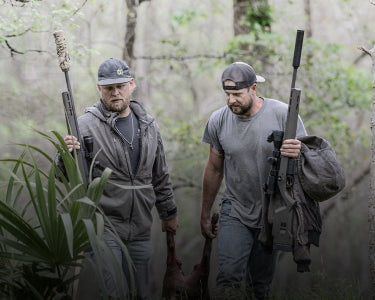You ever walk out into the woods, spot a buck, and think, “That’s a good one” but then wonder if he’s really mature or just has a lucky rack for his age? We’ve all been there. A lot of us grew up hunting deer but never had anyone actually explain how to tell how old a buck really is. Usually, the second you see horns, your heart jumps, and before you know it, the trigger’s pulled.
There’s nothing wrong with that—meat’s meat and all—but if you’re trying to manage deer, hunt bigger bucks, or just understand what’s running around your land, learning to age a whitetail can change the way you hunt forever.
Let’s break down how to tell a deer’s age both before and after the shot.
Why Age Even Matters
First off, aging deer is all about making smarter choices. When you can tell a 1½-year-old from a 5½-year-old, you’re no longer just hunting, you’re managing. You’re helping your herd grow up. Younger bucks get another year or two to hit their prime, and that means more mature deer in your area down the road.
Plus, it’s just plain satisfying to know what you’re shooting. A 4½-year-old buck has been around the block a few times. He’s lived through multiple ruts, dodged more than a few bullets, and probably taught a dozen yearlings how not to get killed. Harvesting him is an accomplishment. Shooting a yearling that barely knows what a doe smells like is… less so. Wouldn’t you rather wait a few years till he gets meatier or grows a better set of antlers?
Aging Deer from Afar (What to Look for Before You Pull the Trigger)
Judging age on the hoof isn’t an exact science, but there are some telltale signs you can pick up once you know what to look for. You’ll be surprised how fast your eye starts catching the differences.
The key is clear optics. Good glass lets you pick up the small stuff—neck thickness, body lines, even how a deer carries himself.
With something like the Solitude 10x42 XD binoculars, you can spot deer clearly at long range in low light. And if you’re in a blind or already scoped in, a Presidio 5-30x56 LR2 FFP gives you that fine detail to tell whether you’re looking at a young buck or a seasoned veteran.
Here’s what to look for:
1½-Year-Olds – The Teenagers
Think of these guys as the scrawny high schoolers of the woods. Long legs, small chests, no muscle. Their antlers usually don’t stick out past the ears, and they still look nervous walking into a field. If you see a “doe with antlers,” that’s a yearling.
2½-Year-Olds – The College Kids
Now they’re starting to fill out but still look lanky. The neck’s a bit thicker, the antlers are getting wider (maybe even with decent mass), but they still don’t scream “mature.” These are the bucks that’ll get your heart racing but make you glad you held off in a year or two.
3½-Year-Olds – The Athletes
This is when the body catches up. The buck looks like a racehorse—lean but muscular. The chest starts to outgrow the hindquarters, and the neck thickens noticeably during the rut. Their antlers look impressive, usually past the ears, but they haven’t hit their full potential yet.
4½-Year-Olds – The Prime Bulls
Now we’re talking. Big chest, thick neck that blends right into the shoulders, heavy body that looks solid from front to back. The stomach and back start to sag just a touch. Antlers are wide, massive, and nearly at their genetic best. This is the kind of deer you take with pride—mature, dominant, and experienced.
5½+ – The Old Kings
They look thick. Bellies hang low, backs are swayed, and their necks are massive during the rut. The legs even start to look short compared to the body. Their faces show age too—long, Roman noses, and dark, stained tarsal glands on the hind legs. You don’t see these guys often, but when you do, you’ll know. They move like they own the woods because they do.
Confirming Age After the Harvest
So you dropped a buck and want to know how close your guess was. There’s one easy way to find out: check the teeth.
Tooth Count
Flip the lower jaw open and count the teeth on one side. Fawns only have a few molars. Once a deer hits about a year and a half, it’ll have six teeth on each side. Now, if that third tooth has three little points, it’s still got baby teeth—meaning the deer’s a yearling. If it’s a two-point tooth, he’s at least 2½ or older.
Tooth Wear
Once all the adult teeth are in, age comes down to wear. The older the deer, the flatter and darker those molars get. A 2½-year-old will still have nice sharp enamel ridges. By 5½, those teeth look worn down, with brown dentin showing through. After that, you’re practically looking at deer dentures.
Practice Makes Perfect (and Good Glass Helps)
You don’t get good at aging deer overnight. It takes time, and it helps to watch a lot of deer without shooting. Sit back with your Solitudes on a summer evening and glass the edges of a field. Start making mental notes about how young vs. mature bucks look.
And when hunting season comes, your Presidio 5-30x56 LR2 FFP will help you make that final judgment. Crank it up and get a close look before you squeeze the trigger. The clear, bright image helps you make the call confidently, even at first or last light.
At the end of the day, aging deer is about respect—for the hunt, the animal, and the land. The more you practice, the more you’ll start recognizing deer you passed in past seasons. You’ll feel a little pride when you finally see that 3-year-old you let walk last year come back bigger and bolder.
So next time you’re glassing a field or sitting in your stand, take a second to look past the rack. Check the neck, the gut, the legs, the posture. Ask yourself how old that buck really is. You might still take him, or you might let him walk—but either way, you’ll be hunting smarter.
Frequently Asked Questions
Why is it important to know a deer’s age before shooting?
Knowing a deer’s age helps hunters make better management decisions. By identifying and passing on younger bucks, hunters allow them to mature, which leads to stronger genetics and healthier herds in future seasons.
How can I tell a buck’s age in the field?
Look at body shape, posture, and neck size. Young bucks have long legs, lean bodies, and small chests, while mature bucks appear thicker, heavier, and more muscular with sagging bellies and necks that blend into their shoulders.
What’s the best equipment for aging deer from a distance?
High-quality optics are key. Binoculars like the Sightmark Solitude 10x42 XD and riflescopes such as the Presidio 5-30x56 LR2 FFP make it easier to see fine details—like neck thickness and body lines—even in low light.
How do I accurately age a deer after the harvest?
Examine the teeth. Younger deer have sharper, lighter-colored molars, while older deer show flattened, darker teeth with more wear. Counting teeth and checking for baby versus adult molars can also reveal if a deer is a yearling or mature.
How can I get better at aging deer?
Practice by observing deer without shooting. Spend time glassing fields and noting differences in body shape and behavior. Over time, your eye will naturally recognize age indicators before you ever pull the trigger.





1 comentario
Good article. No mention of judging the spread by the antlers going past the ear tips. Fully agree, in low light either dawn or dusk, quality optics are essential.